- Boat
- Articles
- About
- Tehani-li Logs
- 2004
- Uligan Maldives
- Man, Oh Man, Oman
- Eritrea: The Nicest Place You’ve Never Heard Of
- Cruising Notes: Oman to Eritrea – From Pirates to Cappucinos
- Old Testament Sudan
- Egypt: Legend, Myth and Reality
- Thoughts on Cruising the Red Sea
- Greece: Civilization Again
- Montenegro
- Malta
- Sardinia, Italy
- Barcelona, Spain
- 2003
- 2002
- 2001
- 2004
- Contact
The Marquesas: Where the Cliffs Meet the Sea
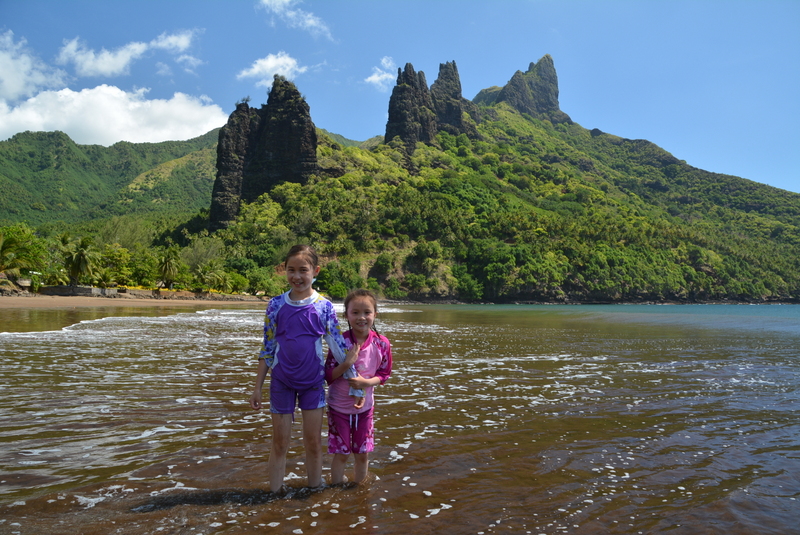
Perhaps you have never been to this place. In fact, unless you are a sailor crossing the Pacific you most likely have never heard of the Marquesas Islands which sit quietly way over on the right side of the map thousands of miles from just about anywhere. There is no oil here, no gold, no beach resorts. In short, the modern world has taken very little notice of this string of stunningly beautiful islands that arose from the deep blue sea in a series of cataclysmic volcanic eruptions a long while ago.
Spanish explorer Mendaña was the first European to visit the islands in 1595 and named them after his boss, (always a shrewd move) the viceroy of Peru. At that time, it is estimated the islands supported a thriving population of around 100,000. Unfortunately, the Marquesas suffered more than most Pacific islands with the coming of the white man who brought “gifts” of syphilis and smallpox. The people had zero natural immunity to smallpox and were almost wiped out by its merciless ravages. By 1900 only 2,000 Marquesans were left. This equates to a population reduction of 98%. Even today, over a hundred years later, there are still less than 10,000 people living in the Marquesas. They have never recovered from contact with Europe.
Polynesians call these islands Te Fenua Enata, “The Land of Men” and they were a central staging point for continued oceanic settlement. From here people sailed their wooden double-hulled canoes two thousand miles southeast to Easter Island. From here they may have sailed two thousand miles northwest and settled Hawaii, as well. Below is a photo of the author and his two daughters by a marae – a traditional platform that supported a building in the old, pre-contact days.
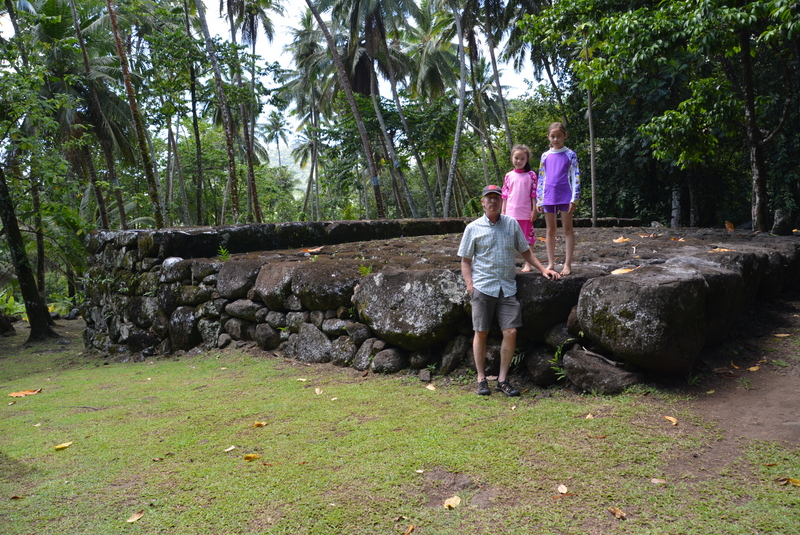
For boats coming from Mexico, or the Panama Canal and Galapagos, the Marquesas are the next logical stepping stone in their long migration across the face of the planet’s greatest ocean and are the first entry to French Polynesia. When we arrive we are totally unprepared as this is not a glamor destination people talk about: “Wouldn’t it be lovely, dear, to go to Tahiti someday? Can you hand me the TV remote?” Nor is it a place people actually go to: “Hey Bob, what are you doing here in Hawaii? Did you see the game?” Nor does it belong to the “I survived” type of places that come with bragging rights for daring visits such as Pakistan, or the Bronx. We have no preconceptions, have heard few, if any stories about the islands and probably have never met anyone who has visited them let alone a real live coconut-husking Marquesan.
Cars only arrived on the islands a few years ago and a lot of people still get around on horseback. There are no five-star resorts and hardly any hotels to speak of. Most people get by living on the fruit that drops from every tree in their garden or working at a fairly stress-free job. It is a pretty relaxed and quiet existence. Until you hear the drums at night.
The Natives are Restless
Almost each night we were in Nuku Hiva, the main island, the rapid-fire staccato of Polynesian drummers thrashing their handmade wooden drums, some small and some five feet tall, into a roaring, whirling wall of percussive sound which bounced off the mountains and raced across the water grabbing your attention with its potent urgency. It made you put down your Hinano beer, sit straight up and exclaim; “What the hell is that?”
All the Marquesans we met are nice, easy going island people but they take their dancing seriously. This is especially true when heiva approaches – the month-long Polynesian cultural event and competition that is celebrated throughout French Polynesia culminating on July 14th in a nod to Bastille Day, the biggest holiday in mother France. Getting ready for this requires months of nightly practice.
What we saw one night ashore was a group of brown, tattooed drummers with brawny hands thrumming in a blur as they created the rapid drum beat. These guys were average looking locals, which is to say they are big, tattooed, muscular, brown and scary looking. And all of them would probably never harbor a mean thought nor do a mean thing. But I wouldn’t want to try them.
The dancers consisted of three rows of women five across of varying ages from matronly fifty-year olds moving with stately grace down to the next superstars of heiva; a couple of energetic nine year old waifs with grass skirts tacked on over their shorts. There were also a few females of child-bearing age, which while lacking the steady confidence of their mothers in the group made up for it with charm, athleticism and attractiveness. The women boldly sang out, their voices mingling in a repetitive high-pitched fluid song while dancing by using gentle hand and arm movements which are connected to hips moving with the drums – faster than the eye can register. In front of the ladies were two beefy men holding down each corner of the group and their “dancing” was not alluring and attractive. Rather, they were threatening, flat out.
These warriors glared at the drummers with bulging eyes and chanted loudly in Marquesan what sounded like all kinds of horrible things they were going to do to the enemy when they caught him. Their deep voices were accompanied by hand movements attached to arms as thick as both my thighs glued together that looked like canoe paddling, limb from body ripping, head twisting off, eye-gouging and tongue ripping out gestures – all in time to music. But they were very graceful.
Wayward Sailor – South Seas Dream
Every Marquesan who comes of age has a dark green tattoos, men and women alike. For them it is not a stupid suburban white thing of trying to “look” cool and tough in the face of overwhelming evidence to the contrary. This is their culture and all tattoos express different affiliations and meanings. Marquesan tattoo artists are also reputed to be the best in all of Polynesia. The designs are have nothing in common with “biker” skull and crossbones or “gang” knives and teardrops. Rather they are intricate mazes of repetitive swirling patterns which spread out like a cyclone to cover an entire shoulder and arm, or half a powerful chest. I had a discussion about tattoos with Kevin Ellis, of Nuku Hiva Yacht Services.
Giving up the joys of living in his car commuting to work in Los Angeles every day, Kevin is now living the South Seas dream. As a wayward American sailor who arrived here on his boat seven years ago, he met and married a local lass and never left. He owns Nuku Hiva Yacht Services and works tirelessly for yachties. I give him the highest possible score as an agent. Kevin is the give-you-the-shirt-off-his-back kind of guy and if he did, the first thing you might notice is all his tattoos. He is built strong like a Marquesan and has had many Polynesian tattoos applied across his ample real estate. In his office at the dock one day dressed in his work clothes of shorts and a sleeveless T-shirt, I was sitting across from him filling out forms for an expected DHL shipment and I asked him about the many different designs.
Me: So, Kevin, tell me about the tattoos on your arms, shoulders, back and neck.
Kevin: (He looks down and starts pointing at the individual tattoos). Well, this one is from my wife’s family. This one over here represents honor and this one along my arm represents courage.
Me: What about the ones on the other side?
Kevin: Some of these are for courage and some are for honor. This one is for bravery. That one is for loyalty. This one is for a hunter.
Me: OK, I’m done with these forms but they all say FedEx. Do you want me to cross that out and put “DHL”?
Kevin: (Realizing he gave me the wrong paperwork). Huh? I’m such an idiot!
Me: Do they have a tattoo for that?
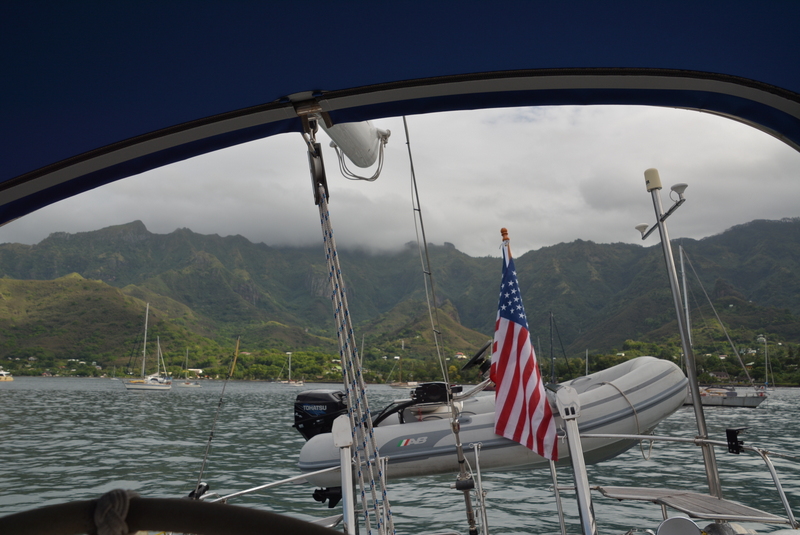
We had several major repairs to undertake while at anchor in oh-so-rolly-when-will-it-stop Taiohae Bay. This meant we were stuck in one place for a while. These islands are relatively “new” and a reef has not had time to grow around it, despite the warm waters which bathe their shores. The lack of a protective reef leaves all the bays open to the restless sea which is never truly calm. Sitting in the corner of the Pacific Ocean thousands of miles from any continent ensures large ocean swells on their way across the planet trip and bang into these islands all day and, it seemed, especially at night.
The Marquesan Challenge
Boats at anchor, there are no marinas mind you, take the brunt of the swells no matter which way the bay seems to be facing. Sitting down at meal times we became accustomed to looking out the windows and seeing only water, a brief flash of land and then only sky, followed by a what looked like land and then only water again as we rolled 30 degrees one way and the next. One night sticks out in my mind as being particularly bad: I couldn’t walk from one end of the boat to the other. It was more of a crawl to go from our bedroom to check on the girls sleeping up front. We felt like being on passage every single day but without the reward of getting anywhere. I began to understand what it would be like living with a 100% income tax where the government takes everything and you never get to enjoy the fruit of your labor.
Sleep did come; for an hour or two before the rolling and crashing of objects on board woke you and it became necessary to reposition your aching limbs or get tossed out of bed. We found sleeping on our backs spread-eagle was the most stable position as it lowered our center of gravity but cannot be said to be comfortable. At all! This was especially cruel after three weeks at sea where sleep was already as rare as a Canadian pineapple.
Throwing out a stern anchor is usually a good solution in keeping the bow of the boat pointing toward the swell to reduce unwanted lateral motion. However, I noticed the few boats that did this rolled almost as much as we did. I assume this was due to the refraction of waves bouncing off all sides of the bay.
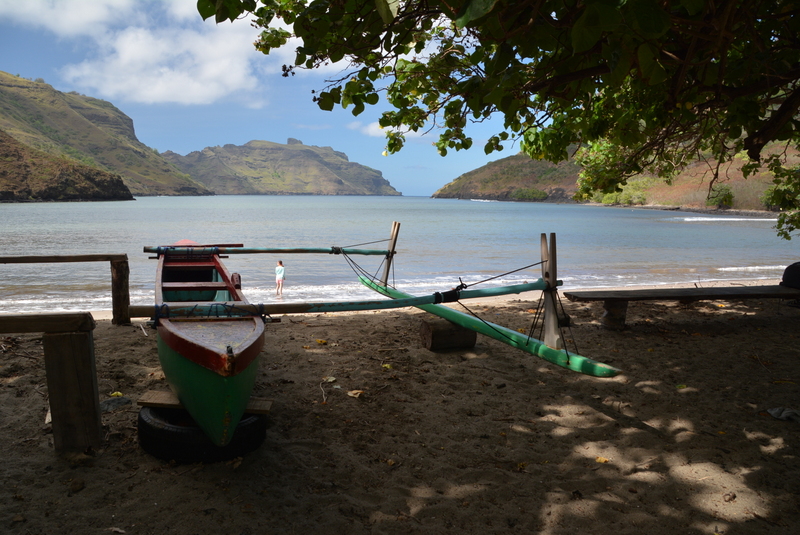
And it was hot. The Marquesas are just 500 miles south of the equator and if the breeze died for a minute beads of sweat competed with each other to be the first to race down your forehead and into your eyes. I ended up buying a $20 electric fan for 60 bucks to plug in to our inverter just to move the air around as our 12-volt shipboard fans weren’t up to the Marquesan challenge.
Well, so what? We were tough and this was a unique place which we were lucky to see. Other yachties in the anchorage pretty much felt the same and there was very little complaining about the rolly conditions and impossibility of sweet surrender to god of sleep.
Night, like middle age, comes quickly in the tropics and the stars burst out of hiding as the sky darkens. The cliffs surrounding the anchorage take on different shapes as elongated dark shadows grew and bent with a rising moon. Then the drums began and one felt that it was still worth it to stay another day.
Woman-hood
And there were the transvestites. Now, I am all for live and let live but this island only had an entire population of around 2,000 people and in my first few days I must have seen a dozen or more “trannies.” There was no doubt when you see a beefy Marquesan male wearing badly applied rouge and lipstick with his hair tied back, floating down the street in pumps stuffed into a skin tight pink dress. No doubt. Their gestures were feminine and they smiled sweetly when you talked to them. And they seemed to be everywhere. Clearly, male transvestites are an accepted part of local culture and nobody we saw ever treated them disdainfully or different than anyone else.
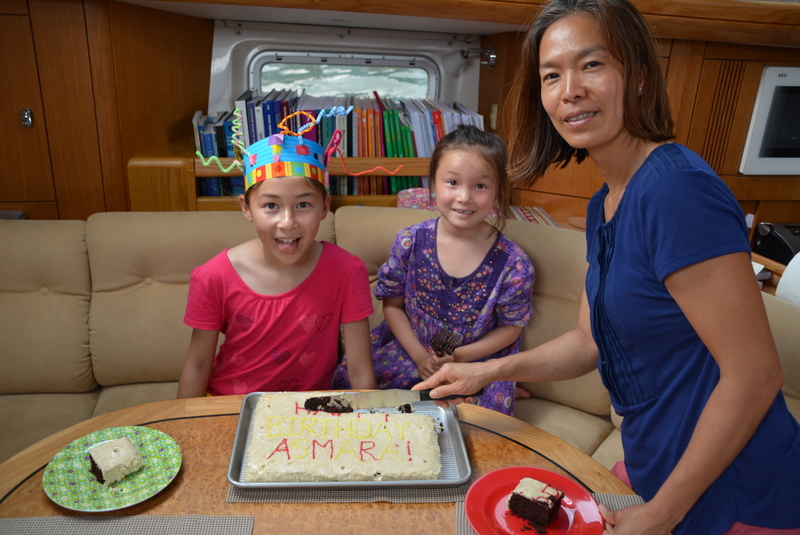
Asmara herself stood on the cusp of womanhood; her ninth birthday came a few days after we arrived. Sadly, she suffers from a family affliction that seems to plague generations of female Hillens: she loves horses, insanely so.
“Daddy, I want a pony for my birthday.”
“Uh-huh.” (If I ignore this will it just go away? I ask myself quietly).
“No, Daddy! Really!”
“How about I draw you a pony?”
“Daddy! No!”
I try and explain that no matter how hard I work nor how long, I will never have enough money to buy a boat big enough to house a pony. Asmara is unimpressed with this line of reasoning. As a compromise, I readily agreed to take her horseback riding on her birthday, which we did and which she loved. I was a good father once again.
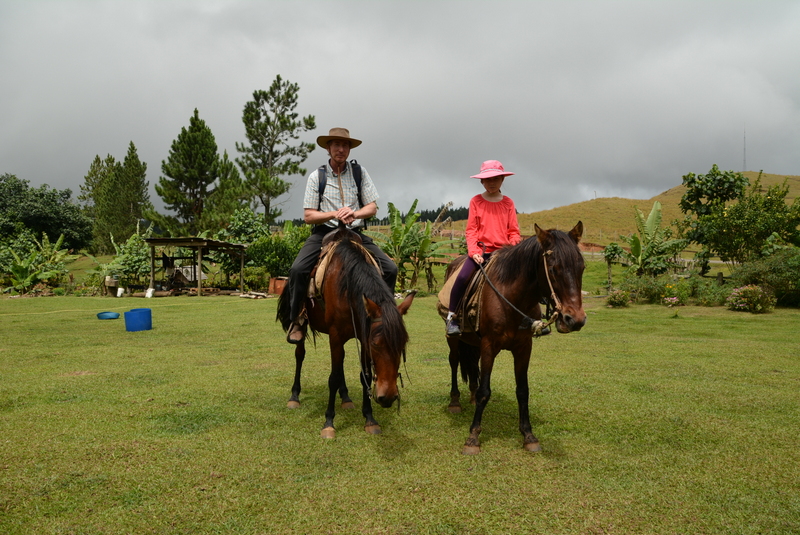
We rented horses which came with a female guide; a piratical-looking and well weathered Marquesan/French lady of advanced middle age. Ciggie clenched manfully between her strong teeth, she drove us in her battered truck high up onto the plateau which forms the central part of this mysterious and bizarre island. The road wound ever higher around green jungle yielding fantastic vistas of Taiohae Bay far below until we crested the highest mountains and turned away from the water onto the plateau. Instantly the tropics disappeared and “Scotty” had beamed us up to Montana. We gazed upward now at towering pine trees interspersed with grassy plains through which of horses grazed and wandered around. Some equines stood on the road and stared balefully at us as we drove by, swishing a tail lazily at an equally lazy fly. Others, hidden in the dales, glens and forests of this weird North American landscape in the South Pacific, jerked their heads upward from grazing and watched as we rattled on by.
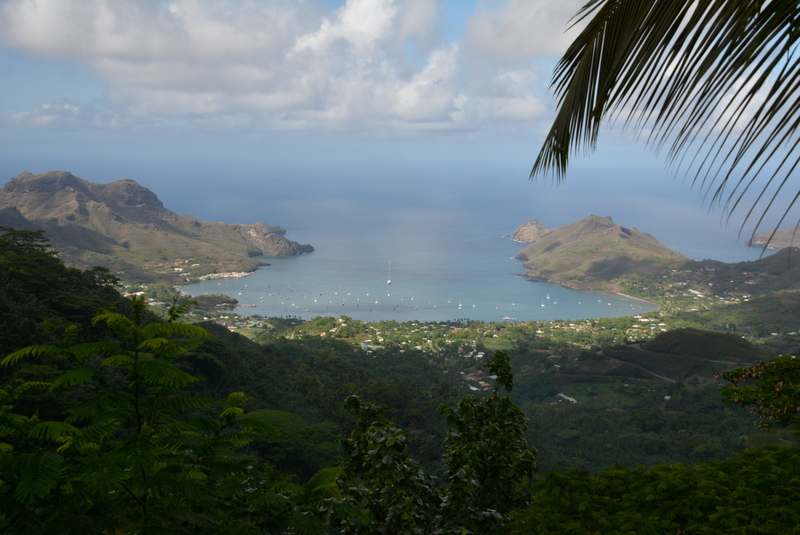
I can’t speak much French but I can get by. Our guide however was more comfortable with silence for our 45 minute trip to her little house along the Bozeman Trail. I was fine with that yet I found it curious was how voluble and talkative she became once we started riding. Her conversational talents, however, were directed solely to the horses. She kept chatting to the horses (which I assume are less fluent in French than even I) and left us to our own thoughts. It was an enjoyable outing nonetheless and sated Asmara’s equestrian desires for at least 24 hours.
A Bagful of Proper Moose
There are two food items the Marquesas are known for in the sailing community: pamplemousse and baguettes. I have, over the years, read numberless accounts written by other cruisers of their landfall in the Marquesas (really quite obscure stuff and only for true aficionados) and they all rave about these two things. And they are half right. Well, I guess they are 100% correct if you have never been to France because the pamplemousse in the Marquesas rock while the baguettes totally suck. There, I said it. The Marquesan versions look like a baguette but they are more like elongated hot dog buns or contemporary pop music: soft and without texture or taste. Marquesan baguettes were also not crisp and a delight to eat like they are in Tahiti (we were to find). The only reason, I can fathom that carb-starved sailors rave about the “yummy baguettes” is because they just spent three to four weeks at sea and probably ran out of bread two weeks into the trip.
“Pamplemousse,” or “proper moose,” as Adriana calls them, is a French word for grapefruit but to call it such would be unfair. Closeted on our island continent, Americans are raised to believe some odd things, such as all grapefruit are yellow, are of the exact same size and should taste like battery acid. Or that by adding a couple easily beaten Canadian teams to the Major Leagues we can always win the World Series and be “World Champions.” I’m here to tell you people: we are getting ripped off. The South Pacific grapefruit, also known as “pomelo,” which is common in Asia, are just wonderful. They are sweet, flavorful, juicy and refreshing. In short, they are as different from American grapefruit as baseball is to butterfly collecting. We greedily inhaled “proper moose” every single day and bought bags of them when we left for our passage to the fruit-free Tuamotus.
Unlike the gloriously deserted Pacific Northwest, in the South Pacific we are finding every anchorage crammed with other boats and in Nuku Hiva’s Taiohae Bay there were nearly 50 of them which was a bit of a shock. To get here, everyone has had to sacrifice, save and strive and all have their own story. And the story of Loukia may be the one of the more interesting.
She is a Westsail 32, a double-ender built during the Brady Bunch era. She is fairly beaten up and slow but remains a sturdy boat. Trailing behind Loukia on a thin grey painter in the anchorage is her tiny engineless wooden dinghy, fidgeting nervously at every small wave and puff of wind, which the two skinny Canucks on board, Garret and Kyle, very carefully row into town. The dink can just fit both of them but not much else. It turns out the boat which says “Nanaimo, BC” was actually purchased in Mexico and it is from there the guys sailed just under 3,000 miles to this bay. They do not own the boat. They are not lifelong sailors. They are from Winnipeg, the center of the frozen north and home of the coldest street corner in Canada: Portage and Main.
I asked the obvious question, how did two young guys, they must be in their late-20s, from right in the middle of the prairies end up on an ancient Westsail 32 here in Nuku Hiva? They told me they flew down to Mexico to help their friend, another dude from “Winterpeg” to get the boat ready for the Pacific crossing. This fellow had just bought Loukia in Mexico from, we assume, the guy who sailed her down from Nanaimo, Canada. Like many before him and many to come, he suffered grievously from big dreams of crossing the warm seas of the South Pacific under sail and, being a gregarious sort, wanted his friends to join him. The three musketeers worked together to get her ready (minimal preparation to my eye) and departed Mexico.
The first day out after leaving port is always difficult and requires adjustment and it was no different for the prairie crew of Loukia. A man of action but not of water, the owner of the boat decided that day “he didn’t like it” and told them to turn around and head back to Mexico. The dreamer from the flatland was done with his sailing fantasy and flew home back to a place where the land, like the sea, goes on forever but at least it doesn’t move. However, his generous parting words to Garret and Kyle was to take the boat wherever they wanted and when they were done to give her to a local broker to sell. So these two guys with zero boat experience, to their credit, do just that. They drifted and sailed across the Pacific to Nuku Hiva and anchored here in the bay near us. “It was our first time anchoring. Ever.” Garret told me proudly. This sent a few shivers down my spine as I smiled encouragingly while making a mental note to watch their boat first for dragging if the wind ever picked up.
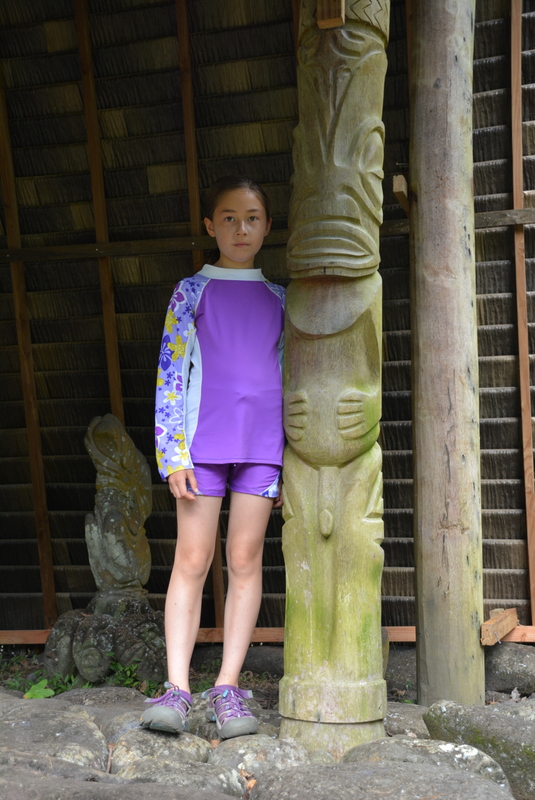
Young bachelors, unless they are perhaps French, are not usually noted for taking keen interest in meal preparation. Loukia without a refrigerator and a watermaker would be a challenging galley for even the most experienced celebrity chef. Chef’s they are not; they are pilots and if they are like any of the other pilots I have known, just boiling water successfully is a major achievement. So it should be no surprise that after four weeks at sea the thoughts and passions of the crew of TGS Loukia would be alimentary in nature.
“Have you tried any of the restaurants?” I asked them the other day when we met on shore. The word restaurant may conjure up images of white table clothes, attentive waiters, air-conditioning and even a wine list. Not here. These are open air road-side shacks with plenty of flies. The people are warm but definitely not in a hurry to provide you with a fine dining experience. The menu is basic in the extreme: omelets (just eggs), chow mein, raw fish in coconut milk and hamburgers are all that we have seen so far.
“Yeah,” Kyle standing there in old shorts, a ragged T-shirt and sporting an equally ragged red beard answered enthusiastically to my question. “We had hamburgers at that place over there.” He motioned vaguely toward a small building near the garbage cans that I didn’t know even had food.
“Were they good?” I asked surprised.
“SOOO Good,” he replied with feeling rolling his eyes and sighing at the memory. His friend, Garret, dressed in the same well-worn attire but sporting a black beard agreed, “Soooo good,” and then adding “Man,” for emphasis. Wow, I’ll have to give that one a try, I thought, though I am not usually a fan of hamburgers.
“And we had the chow mein back there,” Kyle told me pointing to the fly-infested stand at the dinghy dock.
“And?” I asked.
“SOOOO Good!” he smiled recalling the recent happy event of eating dubious chow mein with one hand and brushing flies away with the other.
I looked at Garret who immediately gave his opinion nodding slowly, “Yeah. It was SOOOO Good.”
We had had the chow mein there and I remember it was just OK. Not great. Not bad. I began to doubt not the veracity of my new friends dining experiences but rather question their sound sense of judgement.
“And there was the pizza place, too,” Kyle reminded Garret.
“Sooo good?” I asked.
“Yeah,” they both said at the same time, “Soooo good,” and laughed. “You know,” Garret said slowly as he scratched his beard and seemingly realizing it for the first time, “we haven’t had a bad meal yet.” Kyle nodded seriously at his friend’s insight.
We just ran into them in a supermarket in Papeete, Tahiti where I sit writing this. They had shaved their beards and had gained back a couple of pounds, now no longer being invisible when turned sideways. Their shopping cart was full of cans, no fresh food, just cans. I made a comment to them about the huge number of cans they were acquiring and Kyle looked down affectionately at their ready-to-eat haul and replied, “Yeah, you learn to love them, eh.”
Despite the starvation and hard times, Garret and Kyle plan to continue their adventure heading west toward the setting sun and further their culinary experiences of the tinned kind. As I sit here worrying about my generator, water maker and refrigerator, among other things on board, I have to admire their tenacity and Thoreau-like simplicity of cruising life style.
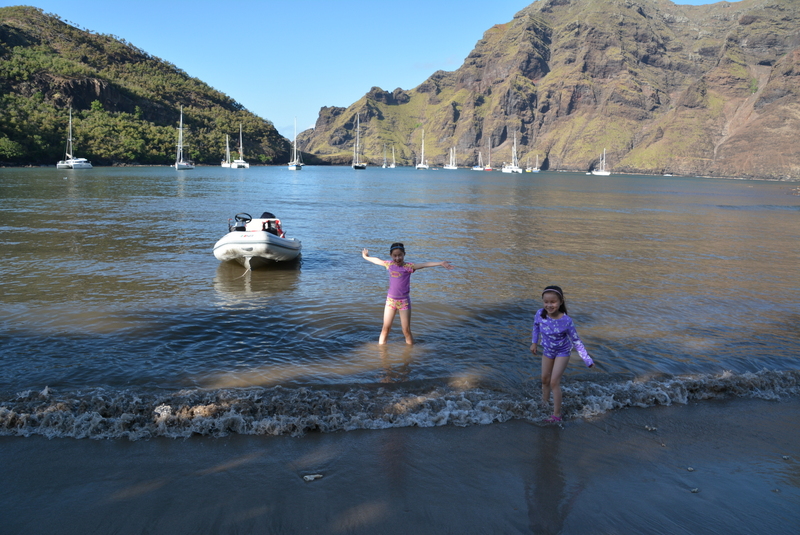
After getting our parts and fixing the generator and the water maker and even forcing the independent-minded fridge to work against its will, we left Taiohae Bay and sailed five miles to anchor in famous (in a Marquesan context) Anse Hakatea, better known as “Daniel’s Bay.” The anchorage was supposed to be gorgeous, and it was, but when we turned the corner, furled our sails and entered the small bay, we saw we were going to have to share it with 20 other boats! Again, I want to point out, for European sailors and US East Coast sailors who grew up with anchoring cheek by jowl or sharing endless mooring fields, this type of crowding is a normal everyday thing. We do not like it. We like the people and admire their boats but we don’t want to live on top of them. “Christ,” I told Ariel after dropping the anchor at the entrance to the bay, the only place with elbow room, “I didn’t sail half way across the Pacific to share each and every anchorage with dozens of boats.”
My log the next day reads:
Leaving “Rolly’s Bay.” Very little sleep last night. Beautiful setting, lousy anchorage. Never a still moment.
We decided to sail on to the next island, which just 25 miles away, was visible on the horizon. Ua-Pou is another geologic wonder and a visual joy to approach under sail. We anchored in Hakahetau Bay with towering rock spires looming over us like giant teeth rising from the mouth of some mountain-eating monster.
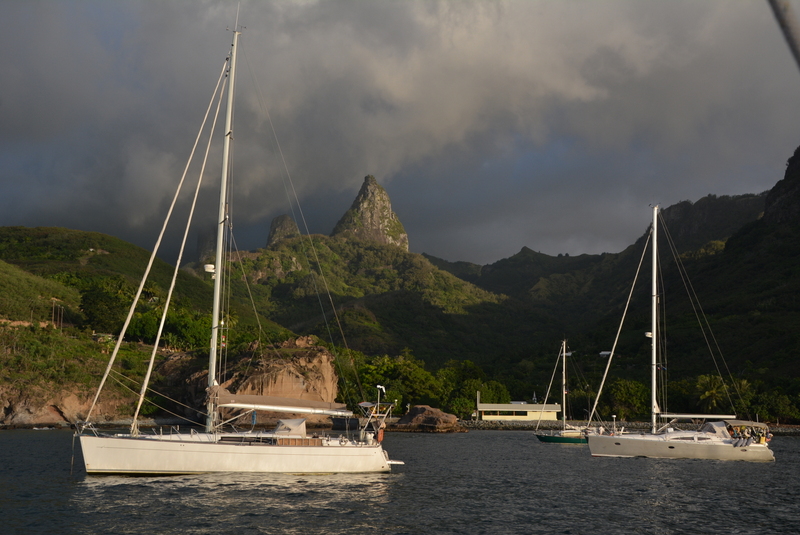
That evening swaying back in forth in the cockpit while watching the sun set we saw the famous “green flash.” This optical illusion happens in the tropics or warm areas right as the last speck of that friendly orb dips below the horizon and winks goodnight. Ariel and I had enjoyed the spectacle several times crossing the Indian Ocean and in the Red Sea years ago but it was a first for Asmara: “Daddy! I saw it! I saw it!” she shouted excitedly. Adriana however, blinked at the wrong moment, “Oh,” she moaned, “I didn’t see anything.”
The log the next day reads:
Leaving another “RFA.” Rolled like hell last night. Heading for the Tuamotus.
I will leave to the reader’s imagination to determine what the “F” is in describing a Marquesan anchorage. Our departure from the Marquesas was not because we thought there was little on offer there but rather because we decided the islands were not suitable, or not really suitable, to visit by boat. The main reasons for this have to do with geography. The islands are truly majestic; dark blue waves crash unceasingly against great green cliffs rising straight up to dizzying heights. Deep lushly vegetated valleys appear here and there between the extinct volcanoes. Yet, the boat at anchor is in constant motion and often the bays are wide open to the sea. The ever present oceanic swell enters as it likes, grabs the sides of your boat and rolls it back and forth mischievously as many times as it can. This usually lasts for 24 hours until a new set of swells rolls by, sees the tempting bait of boats sitting for a few moments unmolested at anchor, steals in and does the same thing. As a result, I have not had a solid night’s sleep since we left San Francisco almost two months ago. Ariel is bleary-eyed as well. The girls fortunately, snug in their pipe berths seem to have the enviable ability of small children and mainland Chinese of being able to sleep through whatever man or nature throws at them. Ariel and I were sleeping crossways (athwartships) on our bunk in the aft cabin to help minimize the rolling but this still only allows for a few hours shuteye a night.
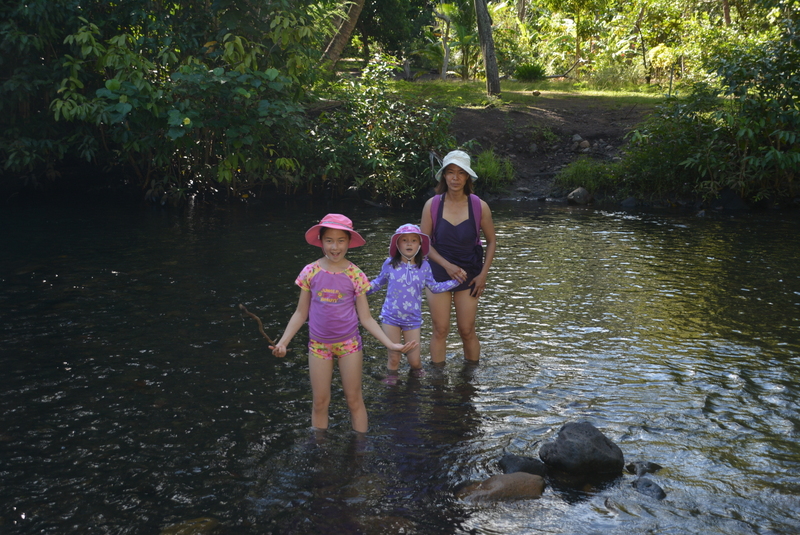
The other problem for us with the Marquesas is the bugs. They did not bother me but positively took a real liking to the sweet flesh of my two little ones. We battled mosquitoes (another gift from Europe) and tiny, voracious no-see-ums known locally as “no-nos,” the girls, despite our best precautions with clothing and bug spray, were each now the miserable owners of about 30 bites a piece. Ariel, as usual, was also a particular favorite food source of these tiny venal, voracious vampires.
Finally, the Marquesas appear to have some really world-class hikes with amazing waterfalls plunging straight down into deep cool freshwater pools that are inviting for swimmers (and rather large eels). However, these great spots are invariably located at the end of long overgrown paths through the bug populated jungle. Our little legs can’t really enjoy that just yet.
“Daddy, where’s the beach?”
A dearth of friendly sandy beaches is the last, and perhaps main, reason for our premature departure. So, off to the string of atolls now called the Tuamotus we go. As we unfurled our sails once more and caught a soft breeze as another pod of courteous Marquesan dolphins escorted us away from the island.
Despite our early abandonment of Te Fenua Entata, I would still recommend a visit to the Marquesas. One can enjoy live Polynesian culture, history and real isolation. Getting to these volcanic marvels is difficult and once there you feel you are living at the end of the world, really off the beaten track. It is a rewarding place but best to see by horse not boat. There are horses roaming everywhere and the locals ride horses as much as drive to go places and given the rambling, de-populated landscape, this would be the preferred mode of travel. Fly in and get yourself a horse. Forget the expensive sailboat.

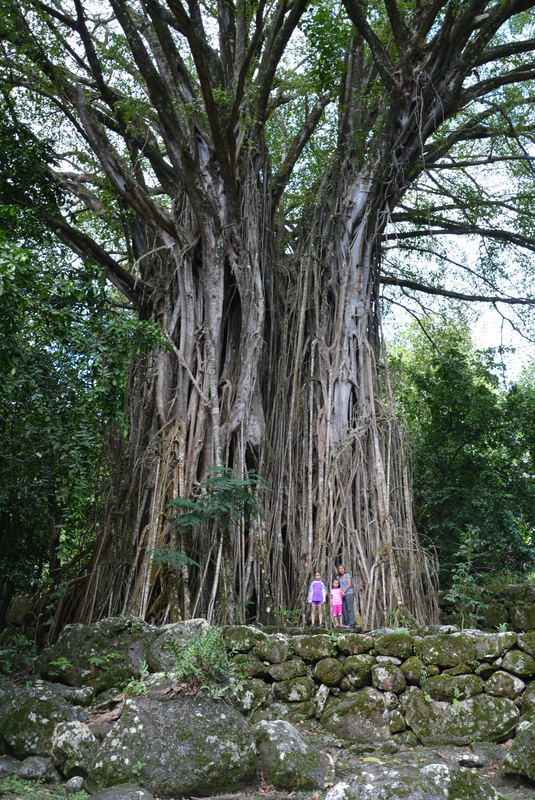
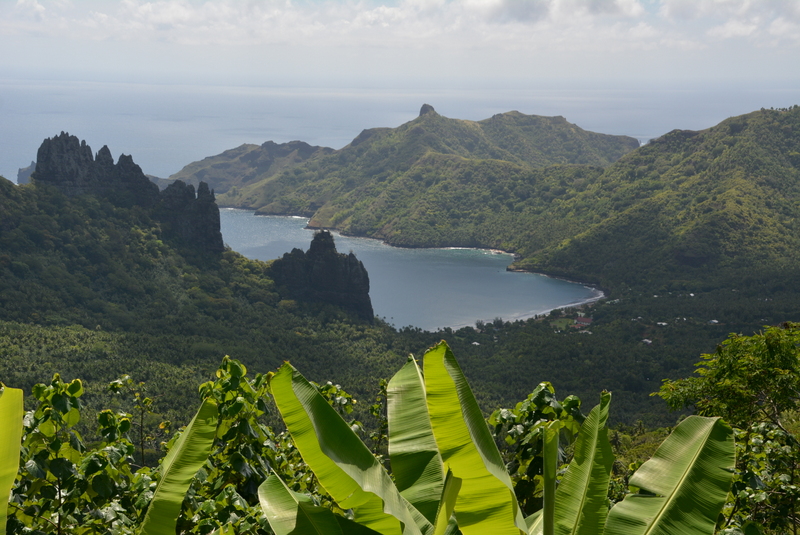
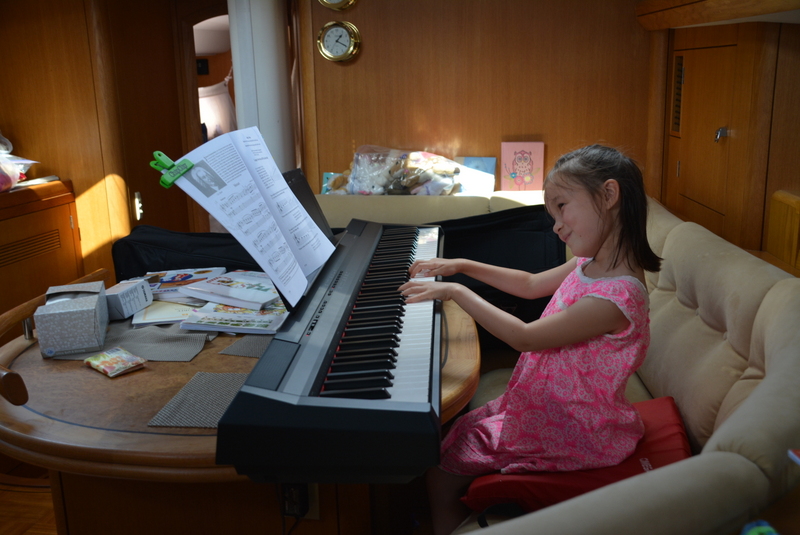
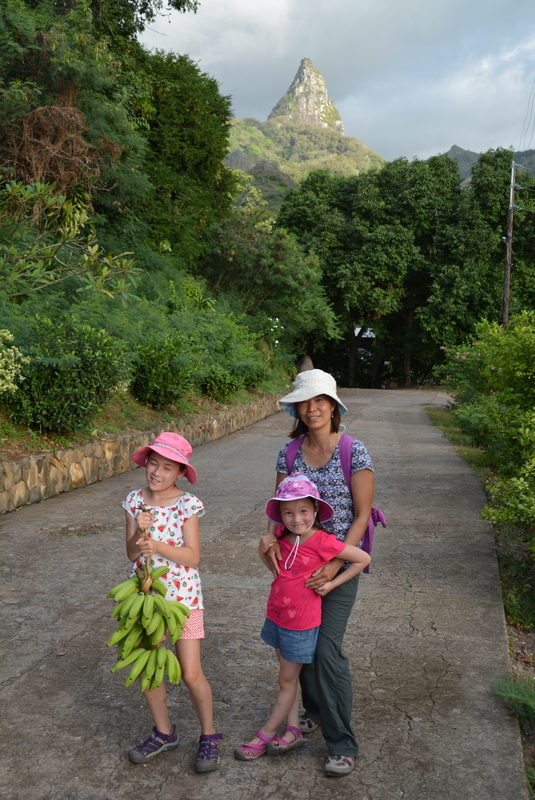

July 9, 2015
4:59 am #comment-1
You didn’t steal those bananas did you? Awesome adventure so far…..love to the family…